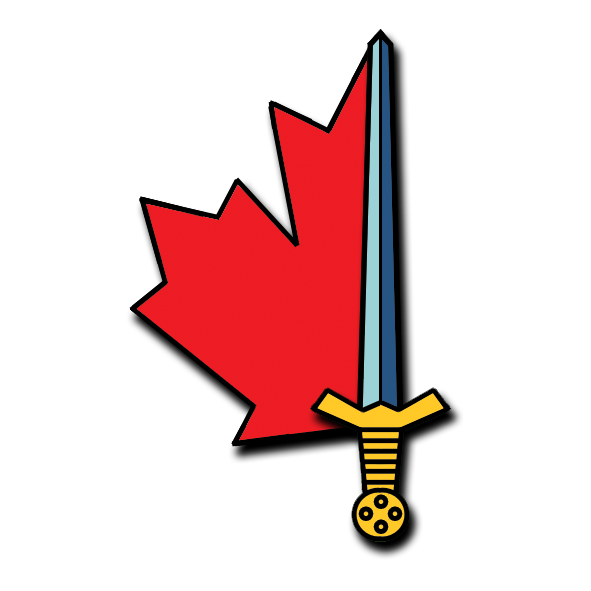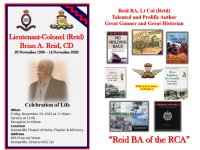- Reaction score
- 6,396
- Points
- 1,360
Brian Reid (historian) - Wikipedia

Old Sweat
 www.army.ca
www.army.ca
The Canadian Artillery family, and army.ca, lost one of it's most noted author/historians this week. I certainly didn't know Brian enough to post much, but every time I was in his company, it was awe inspiring to see how much he remembered names, faces, and details of people he met on his life journey.
I gathered a couple of eulogies/ memories from a few who served with Mr. Reid.
[1} "It was a gut punch hearing the news, I knew it was coming but I’m still having a tough time processing the loss
I had heard about him years ago while on my AIG course when we came across the mystical “Reid graph” Brian had invented this ingenious circular slide rule for calculating gunnery corrections for non standard conditions, while a young IG. For awhile it supplanted the usual way of completing manual calculations, an agonizing process that was akin to doing your personal taxes by hand, whereas Brian’s slide rule produced solutions in mere seconds. It only existed for the C1 though; I’m not sure why similar graphs weren’t created for other guns.
Brian had a wry sense of humour and was sometimes a bit of a rascal. When I visited him and ‘Tish in Nov last yr, I was troubled to see the frail state the two of them were in. Brian, however, was not one for pity, and set me straight by saying I needed to pick out a good book or two before they all ended up disposed at a swap meet or the street. I hesitated so Brian pulled a massive tome on pre WW I gunnery off the shelf, and with a bit of a sardonic tone said “why not start with this” I gratefully accepted then made my way to FJAG’s hacienda with as much of Brian’s “with a few guns” research material as I could find. I then made my way back to Nanaimo, and it became clear lugging Brian’s book through the airports it felt like I was dragging a wheel chock. I gave Brian a shout when I got home, and one of the first things he asked is if I’d had a good workout with the book
Yep, well played sir, well played
It was profoundly sad hearing when his sweetheart ‘Tish passed away, and we knew he would not be long away from her
In the Gunner world he is something of a legend, and of course he is known, too, for his military history works with “no holding back” possibly being the one that stands out the most; that title alone says so much about Brian’s approach to so many things. So there is some comfort knowing he will certainly be remembered well, and missed by many."
[2} "I knew Brian from the old, old days, back in the 1960s. He was a good soldier, both as an enlisted soldier and as an officer. He was a highly skilled "technical" gunner and a fine general tactician, too. I heard him described, by more than one senior officer, more than once, as the best damned FOO here or there or anywhere.
He was also a noted historian with a wide range of interests.
Most importantly he was a good man; a good husband; and a good friend.
He will be sorely missed by more people than he, always a modest man, could ever have imagined.
When they say "an officer and a gentleman" they mean 'Reid, BA of the RCA.' "
[3} "I first ran into Brian in the mess in Shilo in 1969 when he was a Captain IG in the Royal Canadian Artillery School and I was an officer cadet. Cadets didn't interact much with officers in those days and I stayed in Shilo with the 3rd while Brian moved to Gagetown the next year with the school.
He and I really connected the first time in 1973 in 2 RCHA under Howie Wheatley. Brian came in as a newish major to command D Bty, the AMF(L) battery, while I was a GPO in F Bty but because the regiment only had the manning for one battery we frequently worked together.
At the end of May we had just come in from spring practice camp when word came down for two officers to go to the Alps to visit the Italian 1st Mountain Artillery Regiment which at the time had a total of 9 L5 batteries, 8 of which were mule powered. Brian was slated to go and apparently the two battery commanders threw dice at the bar to decide which battery would send a lieutenant along to accompany Brian. Long story short within 48 hours he and I had been vaccinated from head to toes and stood in a railway station in Turin trying to figure out how to get up into the mountains.
After a half day in an Italian jeepish vehicle that makes the Iltis look like a luxury high-powered machine we were welcomed by the regiment's "Colonnello" with healthy doses of Grappa. This would for the next few weeks be heavily supplemented by red wine delivered in jerry cans and cordial produced by the Italian army pharmaceutical corps and packaged in handy little bandoleers of multiple two-ounce plastic packets. They're kind of the rum-ration version for Italian mountain troops.
Brian and I quickly learned that in our quaint little mountain hotel, tiny little 150 millilitre bottles of Birra Moretti came at 300 lira (600 lira to the CA$1.00 at the time) while the litre bottle came at 500. You didn't need to be a gunner to do the math on that - much beer was consumed to mingle with the wine and cordial.
I'll credit Brian with coming up with the idea that the bidets in our rooms were absolutely perfect for washing the mule shit off our combat boots before taking them off. Let me simply say that we learned very quickly not to follow a battery's worth of 80 mules going up a narrow mountain trail. That's one of the places where leading the way is highly preferable. Nonetheless mule shit was inevitable.
Unfortunately Brian is one of the many gunners I lost track of when I left the branch and was very pleased to reconnect with him when I was asked to join the "With A Few Guns" project. The title is, naturally, Brian's idea.
Most of you know Brian has been a historian for a long time. You couldn't shut him up if someone within a hundred yards said the word "Ridgeway". His book "No Holding Back: Operation Totalize, Normandy, August 1944" was a landmark and critically acclaimed study of Canada's first major operation in Normandy.
Jim Bryce, who commanded F Bty when Brian commanded D Bty, was the president of the RCAA by 2006, and he and Ernie Beno brought in Brian to record the history of the Canadian artillery in Afghanistan. The intent was to publish it once the guns came home. No one expected it would take that long as it did and by the end of the war Brian had been diligently interviewing people and researching but the project had been put on the back burner by many people including Brian who went on to other projects. It was revived in 2020 and first our friend @Petard and then I and subsequently Mark Zuehlke were brought on to help Brian do the book.
Unfortunately, by this time Brian was starting to develop a number of health problems that really interfered with what he could and couldn't do. We'd all realized that this was a two book project by then and Brian did continue to be a font of information. His recollection for details of events was remarkable right up to the end. I called him about six weeks ago - the last time that I spoke with Brian - just to check in and to ask a question about an issue going back to the 1950s and he had the facts there instantly.
Brian had a tremendous grasp on the artillery's and army's corporate knowledge right up to the end. Much of it unavailable elsewhere.
Most of you know that Brian's wife, Tish, predeceased him this last June. They were in every respect the gentleman officer and his lady wife in the best of the old army tradition of the term.
They will be greatly missed.
End of Mission, Brian and Tish. Stand Easy."



